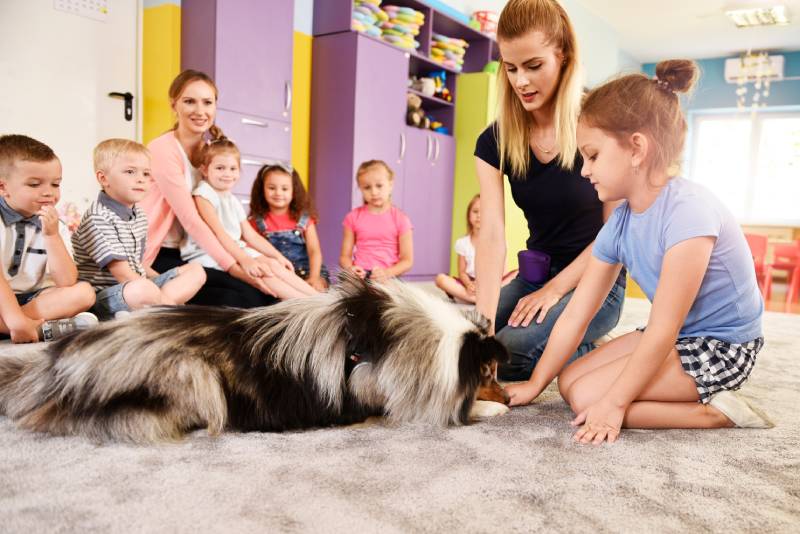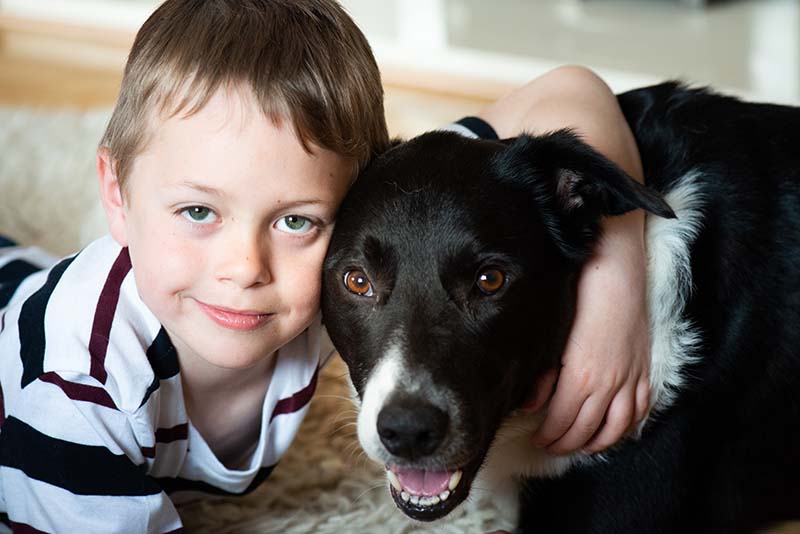In this article
Any dog owner knows how special these animals truly are. Dogs comfort us in times of distress and offer unconditional love, even when we may not deserve it. Dogs are incredible creatures, but don’t just take our word for it—dogs can offer certain types of therapy for individuals that need help and support with daily tasks, including those with autism1.
Dog therapy for autism comes in numerous forms: therapy dogs, service dogs, emotional support dogs, and even family dogs, but how does it work?
In this article, we’ll explore dog therapy for autism and explain how this form of therapy is beneficial and useful. We’ll also discuss how a dog becomes qualified for such tasks.

How Does It Work?
Dog therapy for autism works by helping an autistic person gain more social skills, have better interactions with others, teach life skills, expand verbal and non-verbal communication, increase the desire to participate in activities, and decrease stress in certain situations. Science suggests that having a dog comes with benefits, such as reducing stress, coping with crises, making you more social, and just overall making you happy. Considering these benefits, it’s only fitting that dogs make excellent therapy animals.
Dog therapy can also be known as animal-assisted therapy, and it’s used along with therapists to aid in communication and social skills by encouraging an autistic child to talk to the dog. Animal-assisted therapy can range from therapy dogs to emotional support animals. We should note that service dogs are not considered animal-assisted therapy dogs. We’ll explain the differences later in the article.
Animal-assisted therapy means a dog is specifically trained and lives with the families to perform such tasks as alerting families to early signs of seizures, interrupting repetitive behavior, and preventing an autistic person from wandering. When a person with autism wanders, the consequences can be dire, such as walking into traffic or some other unsafe event. Animal-assisted therapy does not change the characteristics of autism, but this form of therapy can aid in social and communication skills.
Dogs are commonly used for animal-assisted therapy; however, this form of therapy is not limited to a dog. Animal-assisted therapy uses horses, birds, farm animals, guinea pigs, cats, ferrets, and zoo animals for this purpose.

What Are the Different Types of Dog Therapy for Autism?
1. Autism Service Dogs
These dogs undergo specific training for children and adults with autism. Through training, these dogs can increase social interactions, increase vocabulary, improve independence, improve quality of sleep, and provide an overall calmer climate. These dogs are trained for specific tasks and to do specific work for a disabled person; they are also recognized by the Americans with Disabilities Act (ADA). Service dogs are ideal for dog therapy because they are awarded certain rights as opposed to other therapy dogs. For example, a service dog can accompany an individual in places where dogs are generally not permitted, such as plane cabins, restaurants, schools, hotels, and other places where dogs are usually not allowed. A downfall with service dogs is that they are expensive.
2. Emotional Support Animals (ESAs)
Also known as companion dogs, these canines differ from service dogs in that they are pets prescribed by a mental health professional. ESAs are typically not allowed in public places like service dogs but may be allowed in certain areas, such as schools or hospitals. Another difference is ESAs are not specifically trained to do work or perform certain tasks for a disabled person. Still, ESAs can calm and ease anxiety in autistic persons, as well as offer unconditional love.
3. Therapy Dogs
Therapy dogs are a popular choice within the autism community due to their ability to calm down an autistic person. They can also promote social interactions and ease stressful events for a person with autism, such as medical procedures. You can find therapy dogs in hospitals, nursing homes, schools, or other health and mental facilities; they can also assist in occupational and physical therapy sessions. Not all therapy dogs have specific training; however, some do, and if you’re interested in acquiring a therapy dog, we recommend using an accredited agency, such as Assistance Dogs International, to find your therapy dog.

Where Is Dog Therapy for Autism Used?
As we’ve stated, dog therapy can be used in various places, but it depends on the type of dog therapy in place. For example, only service dogs are allowed in places where dogs are not normally allowed, such as plane cabins, restaurants, schools, libraries, or any other establishment where dogs are normally prohibited.
Dog therapy can be used at home, in occupational and physical therapy facilities, nursing homes, retirement homes, hospitals, mental health institutions, hospice facilities, schools, and more. Remember that only service dogs are allowed in all public places, whereas ESAs and therapy dogs are only permitted in certain places. Therapy dogs are often volunteers for dog therapy with their handlers.

Advantages of Dog Therapy for Autism
Studies show that dog therapy increases social behavior and interactions in children and adults with autism. More research is needed, but so far, dog therapy appears to be working to increase social skills, gain more independence, overcome certain fears, and intervene should an autistic person wander into traffic or some other unsafe area.
Disadvantages of Dog Therapy for Autism
Unfortunately, not everyone is a dog person, and if someone with autism is afraid of dogs, you’ll be doing more harm than good. In addition, owning a dog has certain expenses; your therapy dog will need food, bedding, checkups, etc., all of which need to fit into your budget.
Service dogs are expensive, and you must be willing to spend the time and money acquiring one. Also, while service dogs are allowed in public places, private establishments may not allow the service dog inside, such as churches, private homes, or zoos.

Frequently Asked Questions
How Does a Dog Become Qualified for Dog Therapy for Autism?
Service dogs require training to perform specific tasks and to do work specifically for the disabled person. They must pass a public access test and be well-behaved at all times. Service dogs do not require certification in the United States. ESAs and therapy dogs do not require specialized training or certifications, but they may not have access to certain places and areas. However, they are usually allowed in no-pet housing.
ESAs should be able to understand basic commands and be well-mannered with an easy and calm temperament. Any dog can be an ESA as long as they are well mannered and can learn basic commands. To make it legit, you can obtain an ESA letter proving your dog’s status.
How Much Does a Therapy Dog Cost?
Service dogs are expensive to obtain and usually cost roughly $25,000 and up. This is obviously the more expensive route to take. On the other hand, ESAs and therapy dogs are much cheaper and usually only cost the price to obtain the dog in the first place. The costs will depend on the amount of training you pay for the dog and its overall expenses.
What Dog Breeds Are Best for Autism?
Service dogs, ESAs, and therapy dogs range from small to large breeds. Labrador Retrievers, Golden Retrievers, and German Shepherds are used quite often as service dogs due to their high intelligence and loyalty, but other breeds are also excellent for this service. Great Danes, Bernese Mountain Dogs, and Saint Bernards have the strength to aid with mobility, while Toy Poodles can sense blood sugar variations. Labradoodles are better suited for those with allergies to pet dander. In short, any dog breed will do as long as the breed can be trained to learn basic commands and has a calm temperament.

Conclusion
Dogs are incredible creatures and are more than man’s best friend. A therapy dog can greatly improve an autistic person’s life and is worth taking into consideration. You can choose between a service dog, an emotional support animal (ESA), or a therapy dog.
It’s important to understand that not everyone is a dog person, and you’ll need to determine if the autistic person enjoys dogs for dog therapy to be effective. If dog therapy is out of the question, other forms of assisted-animal therapy exist, such as equine therapy, cat therapy, and other therapy animals, such as birds, guinea pigs, ferrets, and more.
Featured Image Credit: RMC42, Shutterstock


















